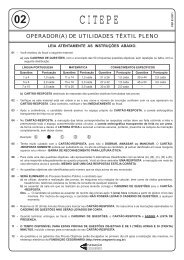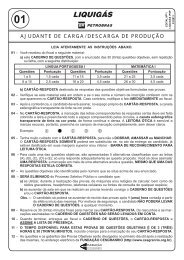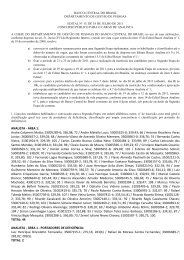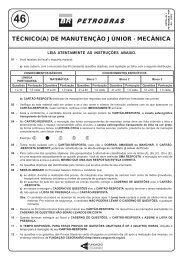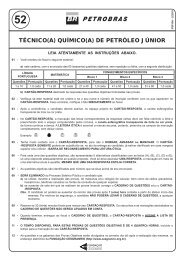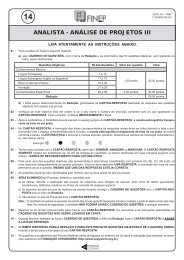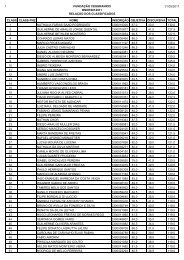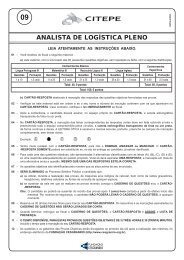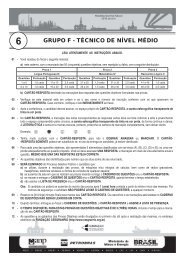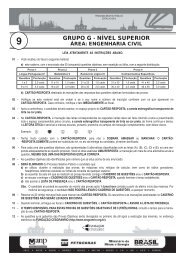PROVA 11 - ENGENHEIRO(A) JÚNIOR - ÁREA ... - Cesgranrio
PROVA 11 - ENGENHEIRO(A) JÚNIOR - ÁREA ... - Cesgranrio
PROVA 11 - ENGENHEIRO(A) JÚNIOR - ÁREA ... - Cesgranrio
You also want an ePaper? Increase the reach of your titles
YUMPU automatically turns print PDFs into web optimized ePapers that Google loves.
5<br />
10<br />
15<br />
20<br />
25<br />
30<br />
35<br />
40<br />
45<br />
LÍNGUA INGLESA<br />
Model copes with chaos to deliver relief<br />
Computer program helps responders transport<br />
supplies in tough conditions<br />
By Rachel Ehrenberg<br />
Science News, Web edition: Monday, February 21 st , 20<strong>11</strong><br />
WASHINGTON — Getting blood or other<br />
perishable supplies to an area that’s been struck by<br />
an earthquake or hurricane isn’t as simple as asking<br />
what brown can do for you. But a new model quickly<br />
determines the best routes and means for delivering<br />
humanitarian aid, even in situations where bridges<br />
are out or airport tarmacs are clogged with planes.<br />
The research, presented February 18 at the<br />
annual meeting of the American Association for the<br />
Advancement of Science, could help get supplies to<br />
areas which have experienced natural disasters or<br />
help prepare for efficient distribution of vaccines when<br />
the flu hits.<br />
Efficient supply chains have long been a goal<br />
of manufacturers, but transport in fragile networks<br />
— where supply, demand and delivery routes may<br />
be in extremely rapid flux — requires a different<br />
approach, said Anna Nagurney of the University of<br />
Massachusetts Amherst, who presented the new work.<br />
Rather than considering the shortest path from one<br />
place to another to maximize profit, her system aims<br />
for the cleanest path at minimum cost, while capturing<br />
factors such as the perishability of the product and<br />
the uncertainty of supply routes. ‘You don’t know<br />
where demand is, so it’s tricky,’ said Nagurney. ‘It’s a<br />
multicriteria decision-making problem.’<br />
By calculating the total cost associated with<br />
each link in a network, accounting for congestion and<br />
incorporating penalties for time and products that are<br />
lost, the computer model calculates the best supply<br />
chain in situations where standard routes may be<br />
disrupted.<br />
‘Mathematical tools are essential to develop<br />
formal means to predict, and to respond to, such<br />
critical perturbations,’ said Iain Couzin of Princeton<br />
University, who uses similar computational tools to<br />
study collective animal behavior. ‘This is particularly<br />
important where response must be rapid and<br />
effective, such as during disaster scenarios … or<br />
during epidemics or breaches of national security.’<br />
The work can be applied to immediate, pressing<br />
situations, such as getting blood, food or medication<br />
to a disaster site, or to longer-term problems such as<br />
determining the best locations for manufacturing flu<br />
vaccines.<br />
.<br />
Retrieved April 7 th , 20<strong>11</strong>.<br />
<strong>ENGENHEIRO</strong>(A) <strong>JÚNIOR</strong> - <strong>ÁREA</strong> MECÂNICA<br />
4<br />
<strong>11</strong><br />
The communicative intention of the article is to<br />
(A) criticize the inefficient transportation of supplies during<br />
stressful events.<br />
(B) announce a study to identify an effective strategy to<br />
distribute goods and services in emergencies.<br />
(C) alert society about the arguments against the delivery<br />
of humanitarian aid during natural disasters.<br />
(D) report on a computational model to speed up the<br />
shipment of perishable products through clogged<br />
roads in summer.<br />
(E) argue that the building of alternative highways is<br />
paramount to a more efficient distribution of supplies<br />
in everyday situations.<br />
12<br />
According to Anna Nagurney, in paragraph 3 (lines 14-26),<br />
an efficient logistics system must consider the<br />
(A) shortest route that links two fragile end points.<br />
(B) only means to take perishable goods by land.<br />
(C) most profitable network, in terms of cheap transport.<br />
(D) lowest cost to place goods safely and in adequate<br />
conditions.<br />
(E) use of standard transportation means normally used<br />
for medical products.<br />
13<br />
Nagurney’s comment “ ‘It’s a multicriteria decision-making<br />
problem.’ ” (lines 25-26) refers to the fact that<br />
(A) in regular deliveries, many problems are caused by<br />
the same factors.<br />
(B) the transportation of unperishable goods is the single<br />
issue to be considered.<br />
(C) finding efficacious transportation solutions depends<br />
exclusively on political decisions.<br />
(D) inefficient management has been multiplying the<br />
problems caused by distribution channels.<br />
(E) delivering products in emergency situations requires<br />
analyzing many factors besides cost and time.<br />
14<br />
Iain Couzin is mentioned in paragraph 5 (lines 33-40)<br />
because he<br />
(A) believes that computational tools are very useful in<br />
predicting and reacting to misfortunate incidents.<br />
(B) provides the only efficient alternative to the computer<br />
model presented by Anna Nagurney.<br />
(C) claims that the use of computational tools in dealing<br />
with disaster scenarios has been ineffective.<br />
(D) found a faster and more reliable means of preventing<br />
epidemics and breaches of security.<br />
(E) developed mathematical tools to justify individual<br />
animal routines.




